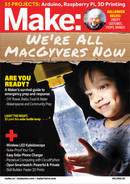
of Production. So I am a big fan and a strong
advocate of open hardware. Just like the web,
however, the Internet of Production must work for
a full range of purposes and revenue models if it
is to incentivize people to connect to it. Further
into the future, I am excited to see how the
Internet of Production might interact with, affect,
or disrupt the global patent system.
Open hardware and good documentation allow
for anything to be made (almost) anywhere.
But most of the engineers I’ve worked with will
automatically start designing a solution before
they check to see if a solution already exists. Field
Ready encourages design and rapid prototyping
in the field with and by the communities we
support. But I often remind our engineers that if
we are designing things then we’re not making
things, and if we’re not making things then
we’re not helping people; we are a humanitarian
organization after all. So I introduce them to
platforms and organizations that share existing
open hardware designs that they might be able to
make and deliver readily in the field.
Across the Maker Movement, I genuinely think
we need now to encourage design reuse with
some form of prize for plagiarism — something
to celebrate the copying and reuse of existing
open hardware — rather than continually
celebrating the new.
People who create are happier than people
who consume. If the Internet of Production
becomes a reality, I genuinely think it will give
everyone the power to create (hardware) and
to determine their own development. It will
help communities to become more resilient,
and less dependent on imports or aid. It will
restore economic activity in places left behind by
globalization and favor a deepening of richness
and complexity in local economies rather than
having to continue the pursuit of unsustainable
economic growth.
Challenges remain in the humanitarian sector.
For very good reasons, the aid sector looks at
people affected by disaster and poverty through a
lens of vulnerability — to see and support those
most at risk. But I think we should all view people
through a lens of capability, not vulnerability.
Through Field Ready, over the last decade, I
have been fortunate to see capabilities emerge
firsthand. An entrepreneur in Nepal now running
3D printing companies. A welder in a refugee
settlement in Uganda making washing machines.
An architecture graduate in Fiji demonstrating
plastic recycling to the U.N. Secretary General
during an international summit. Young business
owners in Bangladesh taking to the factory floor
to retool injection molding machines on the fly
because they weren’t satisfied with the already
impressive quality of their product. FabLab
managers in the Philippines helping local firms
take new products to market. African innovators
making machines to sell to university labs and car
manufacturers. And many more.
So I know these capabilities exist the world
over. And not only should we build upon these
capabilities, particularly in an emergency, but we
should continue to support their emergence. And
I sincerely hope that the Internet of Production —
when it exists — will help them all to compete on
a level, local playing field with General Electric,
Toyota, or Foxconn.
I think the radical change of the next decade
will be to shift the paradigm of production from
mass production to production by the masses.
And I think we will all be better off, happier, and
more resilient if an Internet of Production can
help us all make that radical change.
Learn more:
internetofproduction.org
fieldready.org
andrewlamb.info
43
make.co
Te radical change of the next decade will be to
shift the paradigm of production — from mass
production to production by the masses.
Field Ready
M82_038-43_SS_Emergence_F1.indd 43M82_038-43_SS_Emergence_F1.indd 43 7/11/22 1:45 PM7/11/22 1:45 PM
..................Content has been hidden....................
You can't read the all page of ebook, please click here login for view all page.
